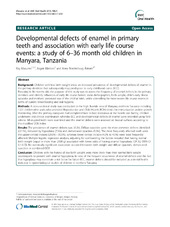| dc.contributor.author | Masumo, Ray | en_US |
| dc.contributor.author | Bårdsen, Asgeir | en_US |
| dc.contributor.author | Åstrøm, Anne Nordrehaug | en_US |
| dc.date.accessioned | 2014-05-23T09:11:35Z | |
| dc.date.available | 2014-05-23T09:11:35Z | |
| dc.date.issued | 2013-05-14 | eng |
| dc.identifier.issn | 1472-6831 | |
| dc.identifier.uri | https://hdl.handle.net/1956/7934 | |
| dc.description.abstract | Background: Children with low birth weight show an increased prevalence of developmental defects of enamel in the primary dentition that subsequently may predispose to early childhood caries (ECC). Focusing 6–36 months old, the purpose of this study was to assess the frequency of enamel defects in the primary dentition and identify influences of early life course factors; socio-demographics, birth weight, child’ s early illness episodes and mothers’ perceived size of the child at birth, whilst controlling for more recent life course events in terms of current breastfeeding and oral hygiene. Methods: A cross-sectional study was conducted in the high fluoride area of Manyara, northern Tanzania including 1221 child-mother pairs who attended Reproductive and Child Health (RCH) clinics for immunization and/or growth monitoring. After the primary caregivers had completed face to face interviews at the health care facility, children underwent oral clinical examination whereby ECC and developmental defects of enamel were recorded using field criteria. All erupted teeth were examined and the enamel defects were assessed on buccal surfaces according to the modified DDE Index. Results: The prevalence of enamel defects was 33.3%. Diffuse opacities were the most common defects identified (23.1%), followed by hypoplasia (7.6%) and demarcated opacities (5.0%). The most frequently affected teeth were the upper central incisors (29.0% - 30.5%), whereas lower central incisors (4.3% to 4.5%) were least frequently affected. Multiple logistic regression analysis, adjusting for confounding the factors revealed that having normal birth weight (equal or more than 2500 g) associated with lower odds of having enamel hypoplasia [OR 0.2 (95% CI 0.1-0.7)]. No statistically significant association occurred between birth weight and diffuse opacities, demarcated opacities or combined DDE. Conclusion: Children with the history of low birth weight were more likely than their normal birth weight counterparts to present with enamel hypoplasia. In view of the frequent occurrence of enamel defects and the fact that hypoplasia may constitute a risk factor for future ECC, enamel defects should be included as a dental health indicator in epidemiological studies of children in northern Tanzania. | en_US |
| dc.language.iso | eng | eng |
| dc.publisher | BioMed Central | eng |
| dc.rights | Attribution CC BY | eng |
| dc.rights.uri | http://creativecommons.org/licenses/by/2.0 | eng |
| dc.title | Developmental defects of enamel in primary teeth and association with early life course events: a study of 6-36 month old children in Manyara, Tanzania | en_US |
| dc.type | Peer reviewed | |
| dc.type | Journal article | |
| dc.date.updated | 2013-08-23T08:50:47Z | |
| dc.description.version | publishedVersion | en_US |
| dc.rights.holder | Ray Masumo et al.; licensee BioMed Central Ltd. | |
| dc.rights.holder | Copyright 2013 Masumo et al.; licensee BioMed Central Ltd. | |
| dc.source.articlenumber | 21 | |
| dc.identifier.doi | https://doi.org/10.1186/1472-6831-13-21 | |
| dc.identifier.cristin | 1044978 | |
| dc.source.journal | BMC Oral Health | |
| dc.source.40 | 13 | |

